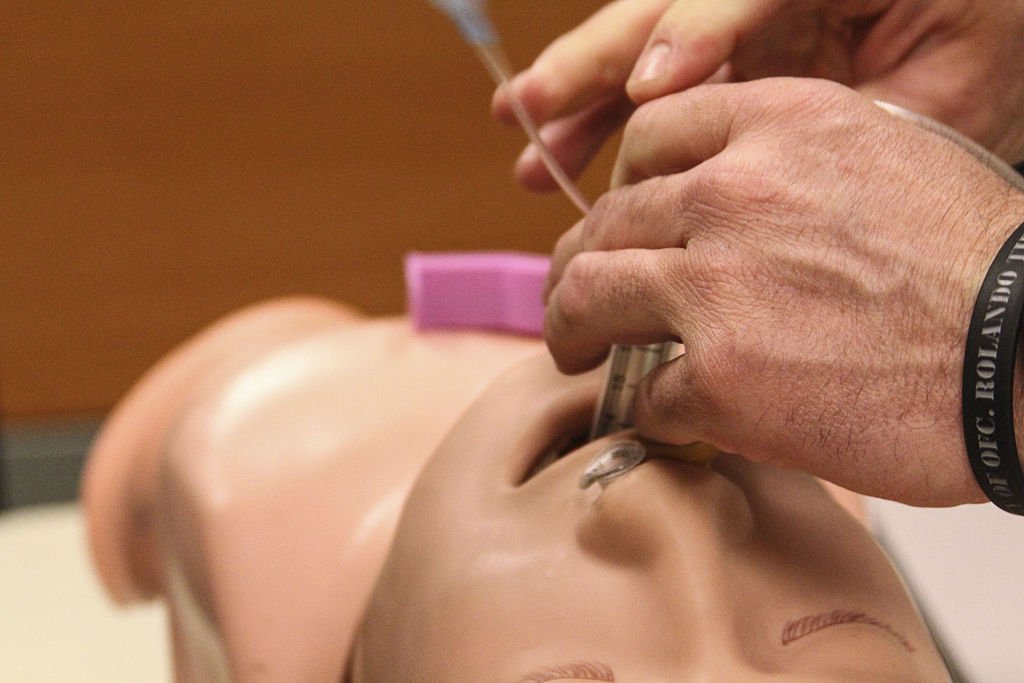
Staff Sgt. Heather Redman, Public domain, via Wikimedia Commons
Critical thinking in airway management is the linchpin that separates proficient healthcare providers from exceptional ones. In the high-stakes world of prehospital emergency medicine, where every second counts, EMTs and paramedics must assess complex situations rapidly and make decisive, well-informed decisions. Critical thinking in airway management involves the ability to analyze patient conditions, anticipate potential complications, and choose the most appropriate interventions based on the available information.
It requires a deep understanding of anatomy, physiology, and the intricacies of airway devices. Moreover, it demands the capacity to adapt swiftly to unexpected challenges, considering various factors like patient anatomy, injuries and coexisting medical conditions. The ability to critically evaluate each scenario, weigh the risks and benefits of different interventions, and adjust the approach in real-time is what sets exceptional healthcare providers apart, ensuring the best possible outcomes for their patients.
In the realm of prehospital emergency care, trauma situations demand rapid, precise and effective interventions. Among the multitude of challenges faced by EMTs and paramedics, mastering trauma airway management stands as one of the most critical skills. The ability to secure and maintain a clear airway in trauma cases often marks the difference between life and death, making this expertise a cornerstone of prehospital emergency medical services.
Understanding the Urgency
Trauma incidents, ranging from motor vehicle accidents to falls and penetrating injuries, frequently lead to compromised airways. Blood, broken teeth, and soft tissue injuries can swiftly obstruct the air passages, impeding breathing and threatening the patient’s life. In these high-pressure situations, the prehospital provider must act swiftly and decisively, utilizing their training to assess, secure, and manage the patient’s airway. Providing effective oxygenation and ventilation is paramount in these critical trauma situations.
Rapid Assessment: The Crucial First Step
Upon arriving at the scene, prehospital providers must conduct a rapid yet thorough trauma assessment. This assessment includes evaluating the patient’s level of consciousness, breathing and circulation. When it comes to the airway, looking for signs of obstruction, such as blood, vomit, or foreign objects, and assess the patient’s ability to maintain a patent airway. Advanced airway assessment is a critical component of emergency medical care, especially in situations where a patient’s airway is compromised or at risk. Unlike basic assessments, advanced airway assessments delve deeper into the intricacies of airway management, considering factors such as anatomical abnormalities, previous airway intervention attempts, and potential challenges posed by the patient’s comorbid medical history.
Prehospital care providers skilled in advanced airway assessment meticulously analyze the patient’s airway anatomy, looking for signs of obstruction, assessing the mobility of the cervical spine, and considering the feasibility of different airway management techniques. This advanced level of assessment allows the provider to make well-informed decisions about the most appropriate and effective interventions, ensuring that patients receive optimal care tailored to their specific airway needs.
Advanced Techniques for Trauma Airway Management
Airway Maneuvers: Basic airway maneuvers like the jaw thrust technique and chin lift can be instrumental in ensuring the airway remains clear. EMTs and paramedics are adept at performing these maneuvers to open the airway without exacerbating potential spinal injuries, which are common in trauma cases. The core skill of basic maneuvers often gets overlooked by advanced providers. These basic skills and devices like the oropharyngeal and nasopharyngeal airways should be the starting point for all providers. Basic maneuvers should also be the safe zone for advanced providers if faced with a failed advanced airway procedure. Most airways can be managed for a short period of time using effective and appropriate basic techniques.
Advanced Airway Adjuncts: In cases where basic maneuvers are insufficient, advanced airway adjuncts like endotracheal intubation or supraglottic airway devices may be necessary. The providers scope of practice may dictate which device are selected. Continues ongoing training and practice in these techniques, will allow them to insert airway devices swiftly and accurately, ensuring an unobstructed passage for oxygenation and ventilation. Moreover, modern technology has equipped EMS professionals with tools like video laryngoscopes, enhancing their ability to secure difficult airways swiftly and efficiently. These advancements have revolutionized prehospital airway management and may have significantly improving patient outcomes.
Cricothyroidotomy: In extreme cases where conventional methods fail, cricothyroidotomy—a surgical airway procedure—is the last resort. Advanced train providers may be allowed withing their scope of practice to perform this rarely used procedure. Only in rare circumstances is it necessary. Critical thinking skills based on education and experience will guide the provider in determining if another less invasive procedure may provide a better patient outcome.
Special Considerations in Trauma Airway Management
Spinal Precautions: Trauma cases often involve the risk of spinal injuries. EMTs and paramedics are trained to maintain spinal precautions while managing the airway. Techniques such as inline spinal motion restriction during intubation are employed to minimize the risk of exacerbating spinal injuries.
Control of Hemorrhage: Severe bleeding in the oropharynx or nasopharynx can rapidly obstruct the airway. Prehospital providers must be able to control hemorrhage promptly, ensuring that the patient’s airway remains clear from blood and clots. The use of suction is often needed to maintain an open airway in these situations.
Continuous Training and Simulation
Mastering trauma airway management requires a blend of theoretical knowledge and hands-on experience. EMTs and paramedics undergo rigorous training on airway management techniques during their initial training programs. However, it is important to conduct regular simulations specifically focused on trauma scenarios that involve airway management. These simulations, should utilize high-fidelity manikins and realistic trauma settings, allow them to hone their skills, improve response times, and enhance decision-making abilities under stress. More important that honing skills during these training situations is to develop a critical thinking process that can be applied in actual patient situations.
Teamwork and Communication
In complex trauma situations, effective teamwork and communication are paramount. Hopefully EMTs and paramedics collaborate seamlessly, ensuring that each team member knows their role and responsibilities. Delegation of duties from the team leader on the scene must be clear and concise leaving no grey areas for misinterpretation of the goals for treatment of the trauma patient. Clear communication with medical control and trauma center/hospital staff is needed to facilitate a smooth transition of care once the patient arrives at the hospital.
The Emotional Toll and Self-Care
Managing trauma cases takes an emotional toll on all healthcare providers. However, EMTs and paramedics witness the raw reality of accidents and injuries, often involving severe trauma or loss of life. Recognizing the emotional challenges, EMS agencies need to provide psychological support, counseling services, and encourage peer support programs. Self-care and mental well-being need to be emphasized, acknowledging the resilience needed to cope with the daily rigors of prehospital trauma care.
Conclusion
In the fast-paced world of prehospital emergency medicine, mastering trauma airway management is an indispensable skill for EMTs and paramedics. The ability to swiftly and effectively secure airways in the face of traumatic injuries transforms chaotic scenes into stories of survival. Through rigorous training, constant skill refinement, utilization of sound critical thinking, and appropriate transport decisions can make a profound difference, ensuring that every trauma patient has the best chance of survival.
References
1. Airway Management in the Critically Ill Patient. Curr Anesthesiol Rep.2021; 11(2): 116–127. Published online 2021 Apr 19. doi: 10.1007/s40140-021-00448-3
2. Chapleau, Wilfred; Chapman, Greg; Hunter, Michael; Mercer, Steven; Pons, Peter; Stuke, Lance. Essentials of PreHospital Trauma Care. International PreHospital Medicine Institute. 2023.
3. Scott Aaron J, O Heard Stephen, Zayaruzny Maksim, Walz Matthias J. Chest 2020 Apr;157(4):877-887. doi: 10.1016/j.chest.2019.10.026. Epub 2019 Nov 9.
Greg Chapman, BS, RRT, CCEMT-P, is a faculty member of the International Prehospital Medicine Institute and Director of the Center for Prehospital Medicine at Carolinas Medical Center in Charlotte, North Carolina.



EMS in the United States must embrace the advanced airway adjuncts especially at the Basic level. The loss of patients due to a non patent airway for many reasons other than trauma requires the adoption of the new adjuncts.